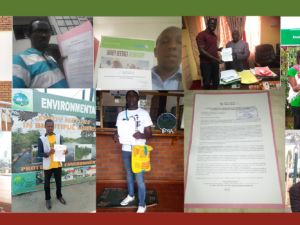
Beginning in 2027, the European Emissions Trading System 2 will go into effect, requiring traded carbon allowances when fuels are sold, effectively putting a carbon price further upstream. The European Commission has reminded member states (except Austria) to implement ETS2 in national law. The aim of ETS2 is to reduce EU greenhouse gas emissions 40 percent.
The requirement for allowances will provide an economic incentive to reduce use of fossil fuels that create heat-trapping emissions, but it will also raise costs for consumers, which could erode public support for this important climate policy. With this in mind, Citizens’ Climate Europe hosted an event on Oct. 16 to explore possible solutions. The hybrid event was held in Brussels and online.
The first presentation from Michael Pahle, Head of Working Group “Climate & Energy” at @Potsdam Institut für Klimafolgenforschung, focused on the ETS2 price evolution and the potential of rebates to cushion excessive increases. After a brief explanation on what sets prices, Pahle showed scenarios of prices ranging from €71 to €261 per ton of CO2 in 2030. He emphasized that in addition to price levels, volatility can be a concern. Stability mechanisms act with a delay, while higher prices for certificates would be passed on to consumers much faster. Together, this creates a case for rebates to citizens as a “social stability mechanism” acting fast if prices increase excessively. Pahle closed with recommended preparation for member states.
Next, James Collis, chair of Citizens’ Climate Europe, took a wider view on carbon pricing, quoting OECD’s and IPCC’s recommendations as well as the FASTER* principles for effective carbon pricing. This set the scene for comparing existing carbon pricing schemes, at €50/t or more, through the lens of these principles. The F in FASTER stands for “Fair,” a key criterion for public support, leading to a discussion of possible implementations of Climate Income (also known as Climate Dividends, Klimabonus, Klimageld), highlighting tools and a possible policy workshop for policy makers.
The final presentation was by Wolfgang Otter, Department Head Klimabonus at Austria’s Ministry of Climate Action, Environment, Energy, Mobility, Innovation and Technology. Otter took participants behind the scenes of how a climate dividend, argued for by Michael Pahle and James Collis, got implemented in Austria under the name of Klimabonus. He outlined the main features: everyone receives it, amounts are regionally staggered taking into account increased costs for mobility in more rural areas, since 2024 Klimabonus is taxed for high income households to increase fairness, and Klimabonus is part of a larger group of measures. He emphasized the importance of simplicity, warning attendees of the trap of fake specificity and recreating social measures that already exist and that adding design complexity significantly impacts implementation cost and success. Finally, he outlined the surprisingly simple but logistically challenging process of paying Austrian citizens’ via bank transfers or vouchers sent by post. He closed with giving a behind the scenes insight into reactions by the public.
These talks were followed by a lively Q&A, ranging from detailed questions about the Klimabonus in Austria to more general questions on social and regional staggering and supporting citizens in investing to decarbonise their lives.
Taken together, the event provided a fascinating insight into the challenges the introduction of ETS2 will result in as well as possible ways to make carbon pricing not only effective, but also socially fair.
Many attendees requested further follow-up and we are excited to understand the specific reasons and see if we are able to support further in the coming weeks and months.
Presentations are available here.
*The FASTER principles are: F for fairness; A for alignment of policies and objectives; S for stability and predictability; T for transparency; E for efficiency and cost-effectiveness and R for reliability and environmental integrity.








